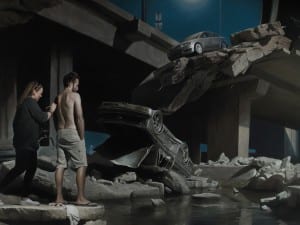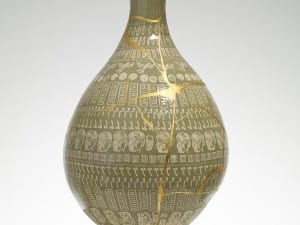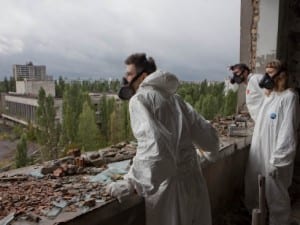Review by Elisa Caldarola
Folk Form Taxa, Alex Bunn’s new show, opened last week at The Aubin Gallery in Shoreditch, London. Ten large light box pictures in a dark room confront and attract the viewer with saturated colours, compositional balance, captivating contrasts. They are often pictures of artefacts we are not accustomed to, the result of the artist’s experimentation with techniques and materials. Organic and inorganic are mixed and what looks like a colourful and sharply designed object reveals a more discomforting nature at a second inspection. Teeth, insects, a bat skull (or is it a mouse?), and what appear to be parts of the entrails of some larger animal are playfully assembled together with pieces of cloth, plastic, metal, silicon and other less easily discernible substances. A push and pull effect is an obvious consequence of the use of rather disgusting materials in images that remain nevertheless sexy.
Bunn’s photographs, however, aim to make a deeper point, and the attraction/repulsion dynamics is only one of the devices the artist puts into play in order to reach his goal. The exhibition leaflet mentions an interest in scientific methods, formal systems, classification, and in particular an epistemological concern with that which is left out by the process of scientific knowledge. Under this light Bunn’s photographs acquire a much broader variety of significance.
Bunn’s subjects are deliberately impenetrable, which enhances their power to fascinate and the feeling that, despite the efforts we put in understanding phenomena, there is always something that our categories miss out. For example, it is not at all clear what is going on among the junk, the electric cables and the toy-like object in the dramatically lighted An Ambivalent Incident (a title that speaks for itself). And what exactly is that metallic thing on a human tongue for (Cecocolic Chamber)? It looks possibly like a dentist’s instrument and yet not, and we can’t tell what it is used for. Nor we can say that it is an instrument of torture. Despite the uncomfortable subject, the image does not have a sadistic overtone and it does not repulse either. It is, first and foremost, an effective mechanism of displacement.
These pictures are comparable to still-life paintings where non-classifiable artefacts have replaced natural objects, and what is natural only appears in disguise (see especially Bruce Gordon, John Zoli Alcock and Falls Church Count Museum). Bunn has mixed the language of the natural and the artefactual to create an idiom that resonates, although we cannot properly grasp it. The images are also documents of an ambitious creative project: Bunn is a self-taught artist who keeps learning new techniques to produce the objects that populate his photographic sets. A single picture often is the final result of multiple work processes. He has also devised a special technique to photograph the objects from several points of view and then to digitally compose a unique image where no section looks out of focus. The result is an enhanced visual reality, another aspect in contrast with the inscrutable character of the photographed objects.
Bunn’s work is original, challenging and beautiful to look at. This is a small-scale exhibition that packs a surprising variety of themes.
www.aubingallery.com Until 5 September 2010
Images © Alex Bunn courtesy The Aubin Gallery
Feedback Ghost
An Ambivalent Incident




